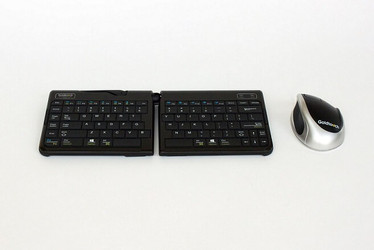The Effects of Walking and Cycling Computer Workstations on Keyboard and Mouse Performance
Posted by Peter Budnick, PhD, CPE on 10th Oct 2017
Researchers Straker, Levine and Campbell (2009) investigated the effect of so called active workstations on the performance of computer operators. Specifically, they tested four workstations, including riding a stationary bicycle at two different speeds, walking on a treadmill at two different speeds, sitting and standing. For each condition, they measured the actual speed and accuracy of mousing and keyboarding activities, the subjects' perceived effects on these performance measures, as well as heart rate and the subjects' perceived exertion levels. Subjects included 14 male and 16 female experienced computer operators, 15 of whom were touch typists and 15 whom were not. The researchers tested subjects while performing a typing task only, a mousing task only, and a combined mousing and typing task.
The researchers found no significant difference in performance measures between the sitting and standing workstation conditions, but did find statistically significant decreases in performance under walking and cycling workstation conditions. The primary results included the following:
Typing performance while walking on a treadmill:
- 6% decrease in actual speed; 17% decrease in perceived speed
- 3% increase in actual error rate; 26% decrease in perceived error rate
- There were no actual performance differences between the walking speeds, but there was a perceived decrease at the faster pace
Typing performance while riding a stationary bicycle:
- 3% decrease in actual speed; 13% decrease in perceived speed
- 0.7% increase in actual error rate; 16% decrease in perceived error rate
- There were no actual performance differences between the cycling speeds, but there was a perceived decrease at the faster pace
Mouse pointing speed performance while walking on a treadmill:
- 14% decrease in actual speed; 26% decrease in perceived speed
- 106% increase in actual error rate; 28% decrease in perceived error rate
- There were no performance differences between the different walking speeds
Mouse pointing speed performance while riding a stationary bicycle:
- 5% decrease in actual speed; 14% decrease in perceived speed
- 61% increase in actual error rate; 13% decrease in perceived error rate
Combined typing and mousing task performance while walking on a treadmill:
- 15% decrease in actual speed; 35% decrease in perceived speed
- 35% increase in actual error rate; 35% decrease in perceived error rate
- There were no performance differences between the different walking speeds
Combined typing and mousing task performance riding a stationary bicycle:
- 3% decrease in actual speed; 17% decrease in perceived speed
- 35% increase in actual error rate; 35% decrease in perceived error rate
- There were no performance differences between the different cycling speeds
Study Limitations
- Only short-term periods were tested in the different workstation conditions; longer term exposure may alter these results
- Different speeds may produce different results (e.g., some subjects suggested that the slow treadmill speed was “'uncomfortably
slow,' that fine motor coordination was affected, and the movement of the display (relative to head) was dizzying)." Allowing users to select their preferred speed may result in a smaller effect on performance.
The Bottom Line -- How this Applies to Ergonomists
Some organizations and individuals are looking for ways to increase activity levels for reasons such as health and weight control, but this research suggests there can be a price to pay in terms of reduced productivity and increased error rates. Customers should be aware of these potential decrements, and weigh the health benefits against these potential costs.
Reference
Straker, Leon; Levine, James; Campbell, Amity, Human Factors, Volume 51, Number 6, December 2009, pp. 831-844(14), available online at the time of this writing at http://hfs.sagepub.com/content/51/6/831.abstract
Note: This article is a summary of the above cited research article and does not include all of the study details. Interested readers are encouraged to read the entire study for complete details and findings.
Originally published on ergoweb.com July 2, 2013.

